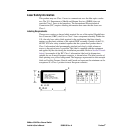
Preliminary
Major Fibre Channel Port Features
SANbox-16HA Fibre Channel Switch
1-2 General Description 59005-03 Rev. A Installer’s/User’s Manual
Major Fibre Channel Port Features
Major Fibre Channel port features include:
• Each Switch chassis has 16 Fibre Channel ports. Each port operates at
1062.5 megabaud.
• Any or all 16 ports may be:
Fabric Ports Fabric ports connect to fibre channel public devices and device
loops. A fabric port is self configuring as an F_Port for a public device
or as an FL_port for a loop of public devices. Refer to “Fabric Port
Overview” on page 1-3.
SL_Ports Segmented Loop Ports (SL_Ports) allow you to divide a Fibre
Channel Private Loop into multiple segments. Each segment of the loop
can pass frames around as an independent loop and can also connect
through the fabric to other segments of the same loop. Refer to
“Segmented Loop Port (SL_Port) Overview” on page 1-3.
TL_Ports. Each Translated Loop Port (TL_Port) connects to a private loop
and allows connectivity between the private loop devices on the loop
and “off-loop” devices (devices not connected to that particular
TL_Port) such as Public fabric devices and private devices on other
TL_Port loops. Refer to “Translated Loop Port (TL_Port) Overview”
on page 1-6.
T_Ports. Trunk Ports (T_Ports) allow the interconnection of multiple chassis
to form larger fabrics. Refer to Section 5 Multi-Chassis Fabrics.
• All ports support Class 2 and Class 3 Fibre Channel service. Refer to Appen-
dix A Reference Information for more information.
• The Switch supports the maximum Fibre Channel frame size (2148 bytes) for
Class 2 and 3 Fibre Channel service. Refer to Appendix A Reference Infor-
mation for more information.
• All ports are supported by GigaBit Interface Converters (GBICs). GBICs
contain the transmitters and receivers that connect to the interconnection
media. Each GBIC is “hot pluggable”.
• Each port has eight buffer credits. This feature allows a cable length up to 13
km at 1 Gbps without performance degradation. F_Port and T_Port credits
can be extended by chaining ports together. Refer to “Port Buffer Credits” on
page 2-10 for more information about extending port credits. Cable length is
also dependant on the type of GBIC used. Refer to Appendix A Reference
Information for more information.


















